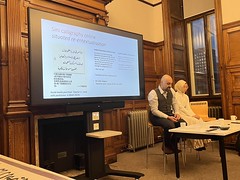
My specialism is ESOL (English for Speakers of other Languages, or EFL/ESL as it is sometimes referred to) and Applied Linguistics; it’s what I teach and research. This blog entry is connected to an essay that I wrote some time ago and, as this blog attracts people with all sorts of issues surrounding education, I hope readers—both ESOL specialists and otherwise—will find it interesting. What follows is a much simplified version of my essay with most academic references eliminated and others kept that general educators may be interested in.
For many ESOL learners in the UK, learning English is a route to better employment, further education, and and/or a key to social integration. In the current socio-political climate, lack of English language skills is cited by some as a possible cause of social divisions between different sections of multicultural Britain (Gerard, 2006; BBC News, 2004). The former Home Secretary David Blunkett went even further by urging British Asian families to speak English at home and to refrain from speaking their ethnic languages in order to overcome what he called ‘schizophrenic rifts between generations of families’ (Hinsliff, 2002). Consequently, second language acquisition (SLA) is by no means a purely linguistic process and, until recently, studies in this area have tended to focus on easily measurable components of language learning, such as the mastery of vocabulary. However, of late, the identity of language learners has emerged as one of the major issues in applied linguistics research. This subject is of particular relevance to language teachers as we are often referred to as ‘cultural mediators’ (A free book on this topic here). In this vein, it is important to look at ESOL teaching from the perspective that language learning is a part of social identity (re)construction, social inclusion, and achieving the larger identity of citizenry in the second culture. Adequate speaking (and pronunciation) skills are instrumental in achieving these goals, as, the way we speak—the way we sound to our interlocutors—is how we project our identity as individuals and how we indicate our membership of particular communities as social beings. Conversely, limited pronunciation skills, resulting in inappropriate or incorrect choices, can restrict social interactions, negatively influence estimations of a speaker’s credibility, language ability, and subsequently undermine self confidence.
The intentional acquisition of a new linguistic identity can result in a ‘seismic mental shift’ (Hoffman, 1989: 105) in a language learner’s interpretation of the world. This is particularly the case with those learners who wish to remain and integrate with the host community and become legitimate participants in the second culture whilst maintaining identification with their native ethnic group. This process was very aptly described by Andrei Codrescu, an American writer of Romanian origin, when he stated in The Woes of Translation (in Raised by Puppets: Only to Be Killed by Research): “I was once a Romanian and I translated myself into an American”. And the sad story of Richard Rodriguez who, through learning English and being told to communicate in English with his family (a language they could but poorly use), subsequently became cut off from them. He confesses to being “paralyzed by the thought of [his parents’] pained faces” when he spoke English to them.
Pronunciation choices—attuning our language to our specific purposes and contexts—are made intuitively by native speakers and how this is to be effectively incorporated into the ESOL classroom is beyond the scope of this article. Nevertheless, some of the students that I teach in Bradford have been attending ESOL classes for several years and bemoan the fact that their pronunciation of certain words and phrases are still grossly inaccurate. Many students—at varying levels—approach me individually requesting ‘accent’ training, as they feel that they only receive sporadic practice in producing accurate spoken language. A series of intimate discussions with my learners has revealed that for many of them, learning English, and their place in British society, is as much about making the right impression as about knowing the language. One particular learner from the Czech Republic told me how his confidence has been ‘hammered’ by his very idiosyncratic pronunciation of English, something that he feels has not been addressed enough in three years of ESOL learning. Most importantly, he felt that this was his main obstacle in finding work—accent discrimination is nothing new, even to native speakers. When the development of spoken competence is neglected from the early stages of ESOL learning, there is a lesser chance of correcting inaccuracies, putting ESOL learners at serious risk educationally and socially.
I believe what my small-scale study reveals are but microcosms of a failure to address a pedagogic need of many ESOL learners. Although I do not say more pronunciation teaching equals (necessarily) better integration, I do say that more emphasis on pronunciation, or even a separate class dedicated particularly to the teaching of segmentals and suprasegmentals in everyday speech, would go some way in addressing this pedagogic need.
In EFL research much has been written about the goals of pronunciation teaching. Is native-like competency a realistic goal? UK ESOL learners live in the country whose language they are learning, and many are part of settled communities. ‘Perfect’ pronunciation is far more conceivable to be a realistic goal in this context than an EFL school in, say, Japan where English is non-existent outside of the classroom.
In this vein, an investigation by Alene Moyer in 1999 is very relevant. This study of 24 Anglophone students[1] in German, found that only one attained native-like competency. What distinguished this one learner was that he had a deep fascination with the German language and culture. This is of particular relevance to ESOL learners in the UK, as, acculturation[2] is a key factor in second language acquisition.
As well as the apparent links above the following may prove useful to ESOL practioners and general educators:
Rodriguez: Hunger of Memory- The Education of Richard Rodriguez
Hoffman: Lost in Translation. A Life in a new language
Morley: Pronunciation component in teaching English to speakers of other languages.
Delpit: Other People’s Children
Kim: Communication and cross-cultural adaptation
Garcia Mayo and Garcia Lecumberri (Eds.): Age and the Acquisition of English as a Foreign Language
[1] All participants had no exposure to German before the age of eleven years.
[2] Acculturation: the process of becoming adapted to a new culture
Categories: Bilingualism, ESOL/EFL, Language











Hi! very thought provoking. Pronunciation rears its head again and again in the classroom but I don’t see many references to it in teachers’ planning documents (for adult ESOL learners). Keep making us look in the mirror!
I so wholeheartedly agree with your comments regarding the application of ESOL participation as a key to social integration. I too am an ESOL specialist and have frequently found that learners attend classes simply to become integrated with the English world around them. My focus in course delivery has almost totally adopted this approach.